U.S. Naval Aircraft Marking
Aircraft of the U.S. Navy and U.S. Marine Corps have carried distinguishing markings almost from the beginning of naval aviation. The earliest being the aircraft building number, preceded by a block letter A, painted on a vertical surface, usually the rudder. Before the United States entered into World War I, naval aircraft were identified by an anchor design on the vertical tail surface, the use of which continued to the time a National Aircraft Insignia was adopted.
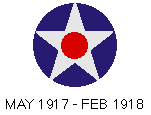
A National Aircraft Insignia consisting of a red disk within a five-pointed white star on a circular blue field, and red, white and blue vertical stripes on the rudder, of the shades specified for the American flag, was adopted.
One of these star designs was to be placed near each wing tip on the upper surface of the top wing and lower surface of the bottom wings. The blue stripe on the rudder was nearest the rudder hinge. This design was ordered to be placed on all U.S. naval aircraft on May 19, 1917. To avoid confusion with enemy markings and to conform more closely with designs used by our allies after our entry into the war, the star design was replaced early in 1918 with concentric circles of red and blue around a white center. The order of the rudder stripes was reversed placing the red forward nearest the rudder hinge. This design was required on all U.S. aircraft operating in Europe.
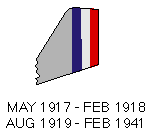
However, not all aircraft at home made the change. This remained in use briefly after World War I, but the earlier star design and rudder markings were soon readopted. The change on naval aircraft was directed on August 19, 1919, to be effective on all aircraft not later than January 1, 1920.
A frequently seen error in this design is the red center being made too large. The circumference of the center circle should be tangent with the sides of the pentagon formed in making the star. The practice of displaying the aircraft serial number in large figures on the side of the fuselage, which began during the war, continued for several years.

Since 1920, numerous additions and changes have been made in aircraft markings which over the years built up an awesome array of variety and detail. The story of these changes is further complicated by the fact that many were instituted by the operating forces without official Navy Department sanction and as a result, some directives issued on the subject did little more than to make standard practice official. Some of the more significant, or possibly more apparent, changes effecting heavier-than-air aircraft of the operating forces since that date were directed as follow.
July 12, 1923
Instructions requiring that the aircraft building letter and number be placed, in 12 inch (30.38 cm) Black letters, on both sides of the body midway between wings and rudder, were modified as permission was given to use squadron designating numbers in their place.
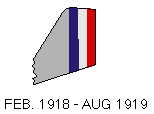
Display of building letter and number in large figures on the sides of the fuselage ended as markings to identify the unit operating the aircraft were ordered placed in that space. With the formation of the Bureau of Aeronautics, this number became known as the Bureau Number. The new markings, which were a grouping of three marks, were described as follows:
For squadrons - the squadron number followed by a letter abbreviation of the squadron mission, followed in turn by a number for the plane within the squadron. Each element was to be separated by a hyphen.
For air stations - same as for squadrons, except that an abbreviation of the station name was substituted for the squadron mission letter. When the plane was from a squadron assigned a combat mission, the station letter was to be followed by the squadron mission letter. Both elements being separated by a hyphen.
The directive also permitted display of a squadron insignia or device on both sides of the fuselage forward of the identification marking.
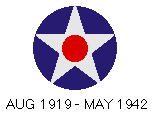
June 24, 1924
Squadron identification markings were ordered placed on Marine Corps aircraft following the system previously prescribed for the Navy except that on Marine aircraft, the mission letter was to be placed within a circle.
The same directive added "U.S. NAVY" on both sides of the fuselage aft of the identification group on all Navy aircraft; no similar provision was ordered for Marine Corps aircraft at this time. The letters were to be as large as possible, but in no case less than 8 inches (20.32 cm) in height.
December 15, 1924
Display of the gunnery pennant and "E" on both sides of the fuselage was authorized. Placement for the pennant was defined as between the leading and trailing edges of the wing, and for the "E" as under the trailing edge.
June 25, 1925
Aircraft for the use of the Marine Corps were to have the fuselage sides unmarked so that the Marine Corps insignia could be applied by the receivlng unit.
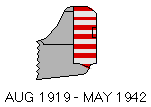
Propeller tips were to be painted with three bands of four inches (10.15 cm) each, with Insignia Red at the tip, then Bright Yellow, then Insignia Blue.
June 1, 1931
Use of 20 inch (50.40 cm) wide colored bands around the fuselage of section leader's planes was directed and the colors Royal Red, White, True Blue, Black, Willow Green, and Lemon Yellow were assigned to sections one through six respectively.
With the fuselage bands, the order further required that chevrons of the same color as the section leader's be painted on all planes of the section; to be placed on the upper wing surface pointing forward. It also added colored bands around the engine cowling in the section color. The leader's plane to carry a complete band, the No. 2 plane a half band on the upper part and the No. 3 plane a half band on the lower portion of the cowl.
The same order permitted use of distinguishing colors on the empennage whenever two or more squadrons of the same type operated together. The colors were to be selected from those specified for section colors but there was no restriction on the assignment or sequence of colors used.
U.S. MARINES was now required on the sides of the fuselage of all aircraft operated by the Marine Corps

November 6, 1931
Branch of service markings - "U.S. NAVY" or "U.S. MARINES" were ordered placed on the lower surface of bottom wings of all planes including those of the Naval Reserve, but excluding training planes. This order was canceled July 8, 1932.
February 1, 1933
Use of a small number on each side of the upper half of the engine cowling was authorized to indicate the number of the plane within a squadron.
March 15, 1937
Distinguishing colors were assigned to each aircraft carrier for use as tail markings by all squadrons on board, thereby ending the practice of assigning colors to squadrons and eliminating the confusion resulting when squadrons transferred from one carrier to another.
Patrol squadron Wings and Squadrons assigned to battleships and cruisers were now identified by a system of solid colored tails, horizontal or vertical stripes, or checkerboard designs.
Responsibility for assigning tail colors-to ot :er Fleet squadrons was given to the Commander-in-Chief, U.S. Fleet.
March 19, 1940
Squadrons engaged in the Neutrality patrol were directed to use an additional national aircraft insignia on each side of the fuselage or hull of aircraft employed.
December 14, 1940
Carrier Air Group Commander's planes were to have a diagonal band, 14 inches (35.56 cm) wide painted around the fuselage forward of the service marking, of the same color as the empennage painting of the carrier group, and the title "COMMANDER (name of ship) GROUP" be painted horizontally on each side of the fuselage.
February 26, 1941
An extensive modification of aircraft marking specifications introduced the following basic changes: . National Aircraft Insignia were added to both sides of the fuselage or hull and two were eliminated from the wings, leaving one on the upper left and one on the lower right. . Branch of Service marking was moved from the fuselage to the vertical fin above the Bureau Number, the figures were reduced in size and letters "U.S." omitted. . Use of colored tail markings, engine cowl bands, chevrons, fuselage bands, gunnery pennant and Marine Corps emblem was discontinued. . Air Group Commander bands were eliminated but use of title continued. . Use of vertical Red, White and Blue rudder stripes was discontinued. . Color of markings other than National Aircraft Insignia became those of least contrast to the background.
January 5, 1942
National Aircraft Insignia were returned to both right and left, upper and lower wing surfaces. Rudder markings were changed to 13 Red and White horizontal stripes.
May 15, 1942
The red disc in the center of the National Aircraft Insignia and horizontal red and white rudder striping were eliminated.
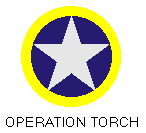
November 1942
In preparation for Operaton Torch, the Allied invasion of French North Africa, an amendment to Operation Memorandum Number 9, dated Sept. 25, 1942, was published by Allied Force Headquarters. It directed that all American aircraft participatng in the invasion display a yellow circle around the national aircraft insignia on each side of the fuselage and on both lower wing surfaces. Since this memorandum was concerned with air-ground recognition, no mention was made of the insignia on the upper wing surfaces. This was a short-lived markng for naval aircraft since they all returned to the United States after the invasion. But it was continued in use in North Africa and Europe by the Army Air Force.
The Invasion of North Africa took place between 8 to 11 November 1942. Carrier aircraft from USS Ranger and the escort carriers USS Sangamon, Suwannee and Santee of Task Group 34.2 of the Western Naval Task Force, covered the landings of Army troops near Casablanca on 8 Nobember and supported their operaton ashore until opposing French capitulated on 11 Noovember. The escort carrier USS Chenango accompanied assault forces to the area and launched her load of 78 Army Air Force P-40s on 10 and 11 November for operations from the field at Port Lyautey.
January 12, 1943
Identification letters and numerals were assigned to air stations of the Operational Training Command and ordered placed on the sides of the fuselage of all aircraft of that Command.
February 1, 1943
One National Aircraft Insignia was again removed from the upper and lower wing surfaces, leaving one on the upper left and one on the lower right.
Tri-colored propeller tips were discontinued by a new requirement that all propellers, except those presenting no hazards to personnel, be painted on both sides from the tip four inches (10.16 cm) inward with Orange Yellow and the remaining blade area including the hub, with Black.
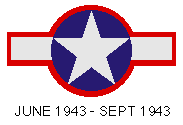
June 28, 1943
A change in the National Aircraft Insignia added White rectangles to the left and right sides of the Blue circular field to form a horizontal bar, and also added a Red border stripe around the entire design. The dimensions of the insignia are based on the diameter of the Blue field. A general rule of thumb for the placement is to be the largest size possible but not to exceed 75 percent of the vertical height of the point of application. On the wings, it normally should be located one-third of the distance from the wing tip to the fuselage.
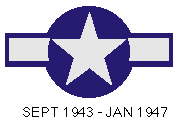
September 14,1943
The red border stripe was eliminated from the National Aircraft Insignia and use of Insignia Blue was ordered in its place.
October 7,1944
The optional display of the gunnery "E" was omitted from marking specifications effective this date. Provision was made for optional use of additional identification markings on combat aircraft by tactical commanders, such markings preferably to be applied with temporary paint. This resulted in many geometric designs.
June 13, 1946
A glossy International Orange band was directed to be applied around the rear fuselage of all Reserve aircraft. The width of the band was to be equal to the outside diameter of the blue border surrounding the National Aircraft Insignia. This band was to just touch, but not overlap, the blue border.
November 7,1946
A letter identification system for marking all Navy and Marine Corps aircraft, including those of the Training Command and the Naval Air Reserve, was adopted and letters were assigned to all carriers, wings, groups and squadrons of the operating forces.
January 2, 1947
Display of unit identification letters was ordered on both sides of the vertical fin and rudder and on the upper right and lower left wing surfaces near the wing tips, thus requiring the relocation of several standard markings.
The model designation-branch of service-serial number grouping was moved from the vertical fin to the fuselage midway between the forward point of the horizontal stabilizer and the lowest point of the fuselage.
The unit aircraft number was moved from the rudder and fin to-the fuselage forward of the National Aircraft Insignia, except on patrol planes where it was placed aft, and also placed on the upper right and lower left wing surfaces inboard of the identification letters. Additional optional locations were specified as on each side of the upper half of the nose and on landing gear fairings.
The space for optional display of squadron insignia was moved to a point below the cockpit rim and forward of the windshield.
Display of unit decorations and campaign ribbons, arranged in a vertical row below the space reserved for squadron insignia, was also optional.
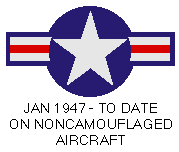
January 14, 1947
A horizontal red stripe, centered on the white horizontal bar, was added to the National Aircraft Insignia.
February 28, 1947
A modification of the letter identification system provided that shorebased aircraft of units and stations, to which letters had not been assigned, would display the air station name or unit title in its place.
May 1, 1948
Changes in aircraft marking specifications made mandatory the use of distinguishing colors for squadrons of a carrier air group on the propeller spinner and across the top of the vertical fin and rudder, assigning Insignia Red, Insignia White, Light Blue, Light Yellow, Light Green, and Black outlined in White respectively for squadrons one through six of each carrier group. Painting of arresting hooks in alternate four inch (10.16 cm) bands of Black and White was also required. Size of Branch of Service, Model Designation, was increased to two inches (5.08 cm). Aircraft Serial Number was increased to 4 inches (10.16 cm).
The new specifications also provided for the optional use of the Marine Corps emblem in place of, but not in addition to a squadron insignia, and the display of the abbreviated rank and last name of the pilot on both sides of the fuselage under the cockpit rim.
February 1, l949
A specific block letter alphabet was shown for the first time. This style has remained in effect to the present time.
May 12, 1950
Branch of service markings -- "NAVY" or "MARINES" -- were greatly increased in size and moved to the fuselage just forward of the empennage
and additionally placed outboard on the under surface of the left wing.
Squadron designation was added and located on the fuselage, centered under Branch of Service, and one-half the height of Branch of Service.
Unit Identification Letters on the under surface of the left wing were moved to the under surface of the right wing, midway between the National Aircraft Insignia and the fuselage.
Unit Aircraft Number on the lower left wing surface was reduced in size and moved inboard.
June 16, 1952
Shore-based aircraft which did not have Visual Identification Letters assigned were to apply the station or unit name to the upper surface of the right wing in the location specified for the Visual Identification Letters. It was also to be applied in smaller letters on the under surface of the right wing.
Aircraft used by Naval Attache were now to carry the words UNITED STATES NAVAL ATTACHE (name of country) on both sides of the forward fuselage. The United States flag was also to be applied to both sides of the vertical fin and rudder.
March 9, 1955
Aircraft operated by components of both the Navy and Marine Corps Reserve could now carry both NAVY and MARINE on the aft fuselage. If used, the station name was omitted.
All identification markings, including the National Aircraft Insignia, on swept-back wings was now to be applied along the 50 percent chord line.


April 1, 1980
Naval Air Reserve aircraft now were identified by two-letter designations the same as Fleet aircraft. Marine Air Reserve had been doing this since January 12, 1972.
April 18, 1985
MIL-STD-2161(AS) made sweeping changes in the painting and markings applied to U.S. naval tactical aircraft with the introduction of tactical paint schemes utilizing two tones of flat gray. All the exterior markings remained. However, they were reduced in size and were to be the contrasting shade of gray to the background to which applied. In the case of Marine Corps aircraft in the land camouflage scheme, the markings were to be flat Black.
The best reference source for a more in depth study on Navy and Marine Corps aircraft markings and color schemes is Mr. John M. Elliott's set of four volumes on the subject. It is the most authorative and in-depth study on the subject. The four books are:
These books were published by Monogram Aviation Publications, P.O. Box 223, Sturbridge, MA 01566. Phone number (508) 347-5574, FAX (508) 347-5772.
29 April 96


